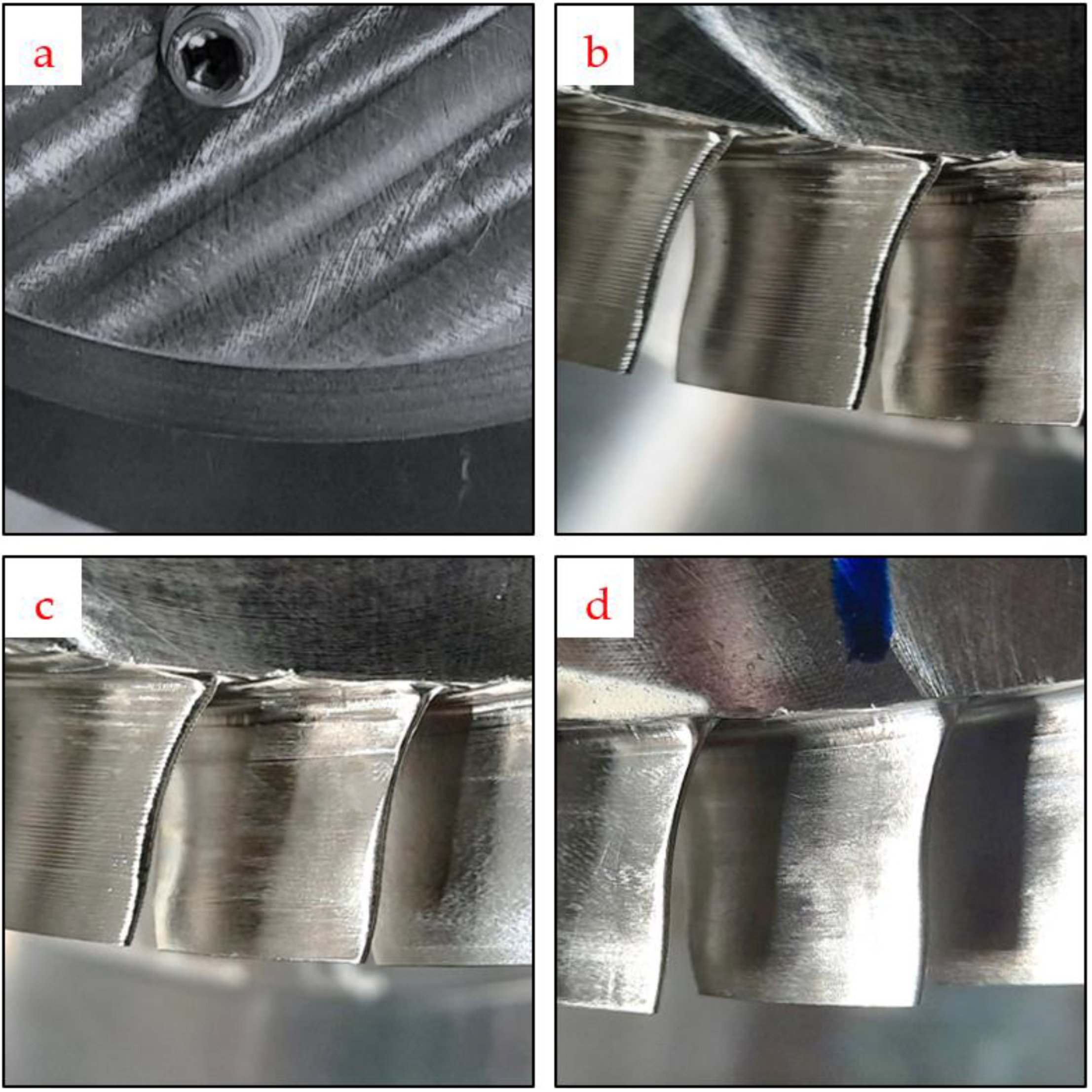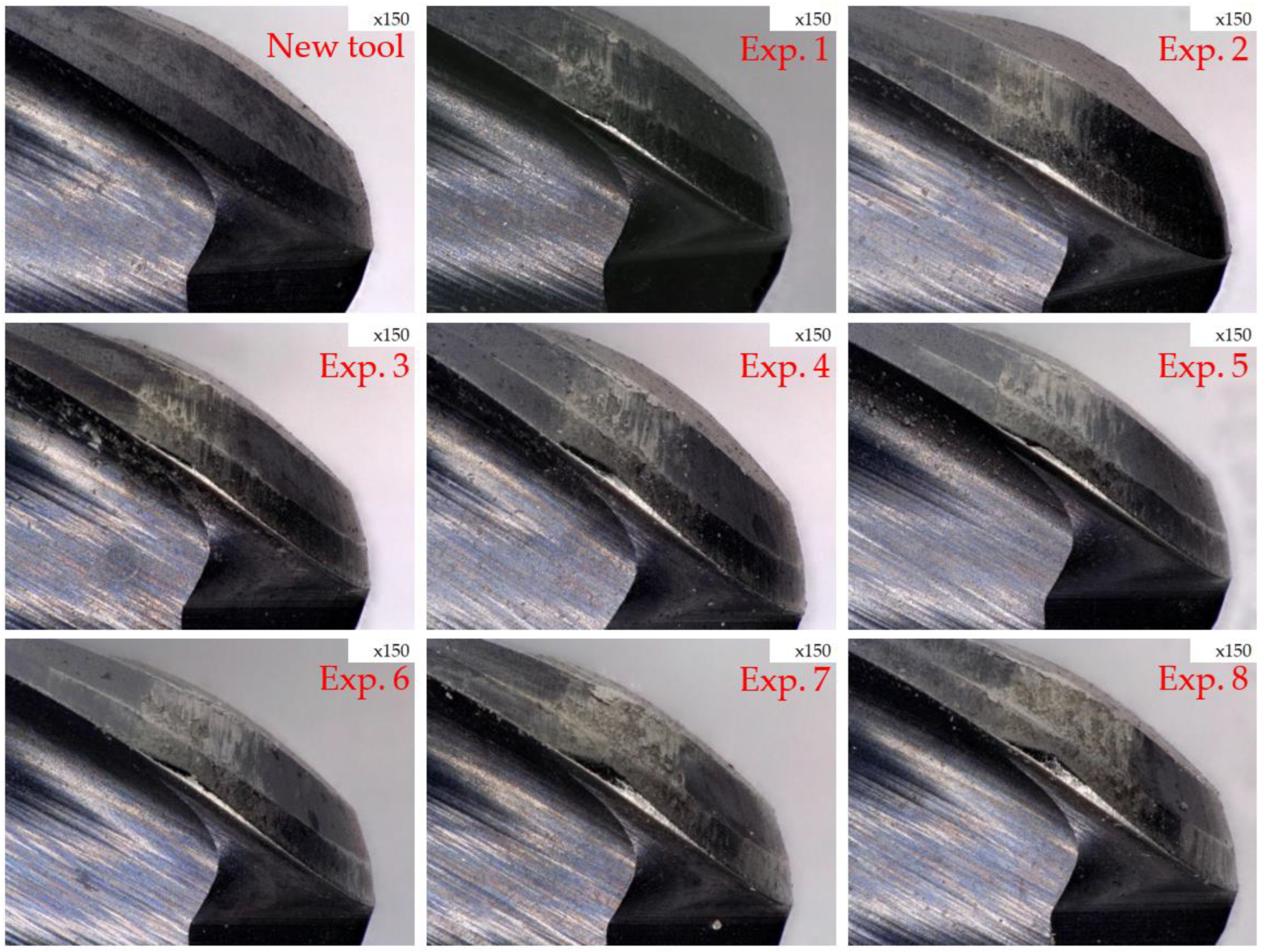Five-Axis Finish Milling Machining for an Inconel 718 Alloy Monolithic Blisk
Abstract
:1. Introduction
2. Machining of Blisk Blades
2.1. The Geometrical Parameters of the Blisk
2.2. Material
2.3. Experimental Equipment
3. Finish Machining Strategy and Method
3.1. Cutting Speed
3.1.1. Processing Conditions and Parameters
3.1.2. Cutting Signal Capture and Analysis
3.1.3. Tool Wear and Cutting Moment
3.2. Feed per Tooth
3.2.1. Processing Conditions and Parameters
3.2.2. Cutting Signal Capture and Analysis
3.2.3. Tool Wear and Cutting Moment
4. Tool Life Test
4.1. Assessment of Surface Roughness
4.2. Repetitive Experiments
4.3. Bending Moment and Tool Wear
5. Conclusions
- A cutting speed between 66 and 76 m/min (effective cutting speed between 46 and 53 m/min) can provide a relatively low cutting force, which can shorten the machining time and maintain surface quality.
- A feed per tooth of 0.05 mm can provide a relatively low cutting force, and a feed per tooth of 0.075 and 0.1 mm can provide relatively high cutting forces, and the values are similar.
- A cutting speed of 66 mm/min (effective cutting speed of 46 m/min) and feed per tooth of 0.1 mm can provide the most stable cutting force and the highest processing efficiency.
- Under the aforementioned conditions, a tapered ball-nose end mill can process a total of eight blades.
Author Contributions
Funding
Institutional Review Board Statement
Informed Consent Statement
Data Availability Statement
Conflicts of Interest
References
- Kuo, C.P.; Su, S.C.; Chen, S.H. Tool life and surface integrity when milling Inconel 718 with coated cemented carbide tools. J. Chin. Inst. Chem. Eng. 2010, 33, 915–922. [Google Scholar] [CrossRef]
- Pereira, O.; Urbikain, G.; Rodríguez, A.; Fernández-Valdivielso, A.; Calleja, A.; Ayesta, I.; López de Lacalle, L.N. Internal cryolubrication approach for Inconel 718 milling. Procedia. Manuf. 2017, 13, 89–93. [Google Scholar] [CrossRef]
- Pereira, O.; Celayab, A.; Urbikaín, G.; Rodríguez, A.; Fernández-Valdivielso, A.; López de Lacalle, L.N. CO2 cryogenic milling of Inconel 718: Cutting forces and tool wear. J. Mater. Res. Technol. 2020, 9, 8459–8468. [Google Scholar] [CrossRef]
- Kurşuncu, B.; ÇAY, V.V. Effect of deep cryogenic treatment on cutting performance in Inconel 718 milling. In Proceedings of the International Engineering and Natural Sciences Conference (IENSC 2019), Diyarbakır, Turkey, 6–8 November 2019; pp. 948–953. [Google Scholar]
- Krain, H.R.; Sharman, A.R.C.; Ridgway, K. Optimisation of tool life and productivity when end milling Inconel 718TM. J. Mater. Process. Technol. 2007, 189, 153–161. [Google Scholar] [CrossRef]
- Szablewski, P.; Dobrowolski, T.; Chwalczuk, T. Optimization of Inconel 718 milling strategies. Mechanik 2019, 92, 824–826. [Google Scholar] [CrossRef]
- Lin, S.Y.; Yang, B.H. Experimental Study of Cutting Performance for Inconel 718 Milling by Various Assisted Machining Techniques. Solid State Phenom. 2019, 294, 129–134. [Google Scholar] [CrossRef]
- Hong, C.C.; Chang, C.L.; Ou, N.R.; Lin, C.Y. CAE Analysis of Primary Shaft Systems in Great Five-Axis Turning-Milling Complex CNC Machine. Proc. Eng. Technol. Innov. 2019, 12, 1–8. [Google Scholar]
- Hong, C.C.; Chang, C.L.; Huang, C.C.; Yang, C.C.; Lin, C.Y. CAE Analysis of Secondary Shaft Systems in Great Five-axis Turning-Milling Complex CNC Machine. Adv. Technol. Innov. 2017, 3, 43–50. [Google Scholar]
- Hu, C.G.; Zhang, D.H.; Ren, J.X.; Yang, L. Research on the 5-axis Machining of Blisk. Mater. Sci. Forum 2006, 532–533, 612–615. [Google Scholar] [CrossRef]
- Huang, J.C.; Liu, X.L.; Yue, C.X.; Cheng, Y.N.; Zhang, H. Tool Path Planning of 5-Axis Finishing Milling Machining for Closed Blisk. Mater. Sci. Forum 2012, 723, 153–158. [Google Scholar] [CrossRef]
- Lu, Y.A.; Ding, Y.; Wang, C.Y.; Zhu, L.M. Tool path generation for five-axis machining of blisks with barrel cutters. Int. J. Prod. Res. 2019, 57, 1300–1314. [Google Scholar] [CrossRef]
- Luo, M.; Hah, C.; Hafeez, H.M. Four-axis trochoidal toolpath planning for rough milling of aero-engine blisks. Chin. J. Aeronaut. 2019, 32, 2009–2016. [Google Scholar] [CrossRef]
- Chen, T.H.; Lee, J.N.; Tsai, M.H.; Shie, M.J.; Lin, C.Y. Optimization of milling parameters based on five-axis machining for centrifugal impeller with titanium alloy. J. Phys. Conf. Ser. 2022, 2345, 012019. [Google Scholar] [CrossRef]
- Liao, Y.S.; Lin, H.M.; Wang, J.H. Behaviors of end milling Inconel 718 superalloy by cemented carbide tools. J. Mater. Process. Technol. 2008, 201, 460–465. [Google Scholar] [CrossRef]
- Xitron Innovation Co., Ltd. Available online: https://www.ixitron.com/ (accessed on 1 October 2022).
- Sharman, A.; Dewes, R.C.; Aspinwall, D.K. Tool life when high speed ball nose end milling Inconel 718. J. Achiev. Mater. 2001, 118, 29–35. [Google Scholar] [CrossRef]
- Jen Wu Cheng Shun Turning Tool Co., Ltd. Available online: http://www.jsk-tools.com.tw/ (accessed on 1 October 2022).
- Lu, Z.; Wang, M.; Dai, W. Machined surface quality monitoring using a wireless sensory tool holder in the machining process. Sensors 2019, 19, 1847. [Google Scholar] [CrossRef]
- Tsai, M.H.; Lee, J.N.; Shie, M.J.; Deng, M.H. Intelligent Performance Prediction of Flank Milling of Ti6Al4V Using Sensory Tool Holder. Sens. Mater. 2022, 34, 3241–3253. [Google Scholar] [CrossRef]
- Daymi, A.; Boujelbene, M.; Linares, J.M.; Bayraktar, E.; Amara, A. Influence of workpiece inclination angle on the surface roughness in ball end milling of the titanium alloy Ti-6Al-4V. J. Achiev. Mater. Manuf. Eng. 2009, 35, 79–86. [Google Scholar]
- Li, C.; Hu, Y.; Zhang, F.; Geng, Y.; Meng, B. Molecular dynamics simulation of laser assisted grinding of GaN crystals. Int. J. Mech. Sci. 2023, 239, 107856. [Google Scholar] [CrossRef]
- Tsai, J.C.; Kuo, C.Y.; Liu, Z.P.; Hsiao, K.H.H. An investigation on the cutting force of milling Inconel 718. MATEC Web Conf. 2018, 169, 01039. [Google Scholar] [CrossRef]
- Özbek, O. Evaluation of Nano Fluids with Minimum Quantity Lubrication in Turning of Ni-Base Superalloy UDIMET 720. Lubricants 2023, 11, 159. [Google Scholar] [CrossRef]

















| Property | Values |
|---|---|
| Outer diameter of the blisk (mm) | 364 |
| Outer diameter of the hub (mm) | 331.5 |
| Length of the blade (mm) | 16.25 |
| Thinnest part of the blade (mm) | 0.23 |
| Thickest part of the blade (mm) | 1.59 |
| Groove width (mm) | 6.46 |
| Number of blades | 78 |
| Property | Values |
|---|---|
| Density (g/cm3) | 8.19 |
| Poisson’s ratio | 0.29 |
| Young’s modulus (GPa) | 200 |
| Ultimate stress (MPa) | 860 |
| Yield stress (MPa) | 551 |
| Elongation (%) | 51.7 |
| Hardness (HRB) | 97.7 |
| Thermal conductivity (W/m·K) | 11.2 |
| Property/Composition | Values |
|---|---|
| Shank diameter (mm) | 6 |
| Tool nose radius (mm) | 1.5 |
| Over length (mm) | 75 |
| Cutting length (mm) | 20 |
| Taper angel (degree) | 3 |
| Rake angle (degree) | 2 |
| Flute helix angle (degree) | 30 |
| Flutes | 2 |
| Material | Tungsten Carbide |
| Coating | AlTiN |
| Property | Values |
|---|---|
| Measuring frequency (Hz) | 2500 |
| Maximum allowable speed (rpm) | 18,000 |
| Operating temperature (°C) | 0–50 |
| Collet size | ER20 |
| Spindle taper | BBT-40 |
| Total length (mm) | 155 |
| Cutting Speed (m/min) | Effective Cutting Speed (m/min) | Feed per Tooth Fz (mm/tooth) | Depth of Cut (mm) | Time (min/s) | |
|---|---|---|---|---|---|
| Exp. 1 | 26 | 18.33 | 0.05 | 0.05 | 56:25 |
| Exp. 2 | 36 | 25.38 | 0.05 | 0.05 | 40:53 |
| Exp. 3 | 46 | 32.43 | 0.05 | 0.05 | 32:08 |
| Exp. 4 | 56 | 39.48 | 0.05 | 0.05 | 26:26 |
| Exp. 5 | 66 | 46.53 | 0.05 | 0.05 | 22:30 |
| Exp. 6 | 76 | 53.59 | 0.05 | 0.05 | 19:43 |
| Exp. 7 | 91 | 64.16 | 0.05 | 0.05 | 16:48 |
| Exp. 8 | 96 | 67.69 | 0.05 | 0.05 | 16:06 |
| Cutting Speed Vc (m/min) | Effective Cutting Speed Ve (m/min) | Feed per Tooth Fz (mm/tooth) | Depth of Cut Ap (mm) | Time (min/s) | |
|---|---|---|---|---|---|
| Exp. 9 | 66 | 46.53 | 0.05 | 0.05 | 22:30 |
| Exp. 10 | 66 | 46.53 | 0.075 | 0.05 | 16:36 |
| Exp. 11 | 66 | 46.53 | 0.1 | 0.05 | 13:02 |
| Exp. 12 | 76 | 53.59 | 0.05 | 0.05 | 19:43 |
| Exp. 13 | 76 | 53.59 | 0.075 | 0.05 | 14:09 |
| Exp. 14 | 76 | 53.59 | 0.1 | 0.05 | 12:14 |
| Cutting Speed Vc (m/min) | Effective Cutting Speed Ve (m/min) | Feed per Tooth Fz (mm/tooth) | Depth of Cut Ap (mm) | Time (min/s) | |
|---|---|---|---|---|---|
| Exp. 15~26 | 66 | 46.53 | 0.1 | 0.05 | 13:02 |
Disclaimer/Publisher’s Note: The statements, opinions and data contained in all publications are solely those of the individual author(s) and contributor(s) and not of MDPI and/or the editor(s). MDPI and/or the editor(s) disclaim responsibility for any injury to people or property resulting from any ideas, methods, instructions or products referred to in the content. |
© 2024 by the authors. Licensee MDPI, Basel, Switzerland. This article is an open access article distributed under the terms and conditions of the Creative Commons Attribution (CC BY) license (https://creativecommons.org/licenses/by/4.0/).
Share and Cite
Tsai, M.-H.; Chen, T.-H.; Lee, J.-N.; Hsu, T.-L.; Huang, D.-K. Five-Axis Finish Milling Machining for an Inconel 718 Alloy Monolithic Blisk. Appl. Sci. 2024, 14, 4015. https://doi.org/10.3390/app14104015
Tsai M-H, Chen T-H, Lee J-N, Hsu T-L, Huang D-K. Five-Axis Finish Milling Machining for an Inconel 718 Alloy Monolithic Blisk. Applied Sciences. 2024; 14(10):4015. https://doi.org/10.3390/app14104015
Chicago/Turabian StyleTsai, Ming-Hsu, Teng-Hui Chen, Jeng-Nan Lee, Tai-Lin Hsu, and Dong-Ke Huang. 2024. "Five-Axis Finish Milling Machining for an Inconel 718 Alloy Monolithic Blisk" Applied Sciences 14, no. 10: 4015. https://doi.org/10.3390/app14104015






